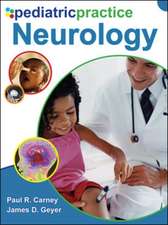Thermoregulation of Sick and Low Birth Weight Neonates: Temperature Control. Temperature Monitoring. Thermal Environment
Editat de Albert Okken, Jochim Kochen Limba Engleză Paperback – 15 dec 2011
Preț: 713.70 lei
Preț vechi: 751.25 lei
-5% Nou
Puncte Express: 1071
Preț estimativ în valută:
136.58€ • 148.31$ • 114.73£
136.58€ • 148.31$ • 114.73£
Carte tipărită la comandă
Livrare economică 22 aprilie-06 mai
Preluare comenzi: 021 569.72.76
Specificații
ISBN-13: 9783642799365
ISBN-10: 3642799361
Pagini: 260
Ilustrații: XIII, 241 p.
Dimensiuni: 155 x 235 x 14 mm
Greutate: 0.37 kg
Ediția:Softcover reprint of the original 1st ed. 1995
Editura: Springer Berlin, Heidelberg
Colecția Springer
Locul publicării:Berlin, Heidelberg, Germany
ISBN-10: 3642799361
Pagini: 260
Ilustrații: XIII, 241 p.
Dimensiuni: 155 x 235 x 14 mm
Greutate: 0.37 kg
Ediția:Softcover reprint of the original 1st ed. 1995
Editura: Springer Berlin, Heidelberg
Colecția Springer
Locul publicării:Berlin, Heidelberg, Germany
Public țintă
ResearchDescriere
Over the past 15 years, the population of sick neonates has changed. The average birthweight has decreased dramatically to as low as 450g while gestational age has been reduced to 22-21 weeks. These babies have totally different needs and require more complex health care. It is now time to change previous recommendations which were based on more mature neonates. In this foreword we aim to give some of the background into the ideas which lead to us starting work on new guidelines. The question was : Can the thermal condition of the baby be better monitored and investigated and, if so, how? Measurement of body temperature remains a very important method of ascertaining the thermal condition of a newborn baby. There is an implicit international agreement that the body temperature of an infant is measured either intermittently using a liquid expansion thermometer or continuously by means of temperature sensors placed in the rectum or the axilla. Rectal temperature is not necessarily identical to the core temperature. There may be up to a 2 °C difference and this could result in an incorrect assessment of the condition of the patient. For example in the presence of cold lower limbs, the cool venous blood returning from the legs will flow close to the rectum and, as a result, the rectal temperature may be significantly lower than that of the core. Other workers have shown how rectal temperature depends on the depth to which the sensor has been inserted.
Cuprins
Thermodynamic Principles.- 1 The Concept of Thermoregulation.- 2 Metabolic Background of Neonatal Heat Production, Energy Balance, Metabolic Response to Heat and Cold.- 3 Physics of Neonatal Heat Transfer, Routes of Heat Loss and Heat Gain.- 4 Body Temperature in Sick Neonates, Deseases and Biochemical Disturbances.- Temperature Monitoring.- 5 Temperature Measurements and Distribution of Temperatures throughout the Body in Neonates.- 6 Thermal Monitoring of very Preterm Infants. Which Temperature should be Measured?.- 7 Experiences with Thermal Monitoring, Influence of Neonatal Care and how should it be Monitored.- 8 Temperature Control in Preterm Infants — Effect of Birthweight and Gestational Age.- 9 Thermal Monitoring in Sick Neonates.- Optimal Thermal Environment.- 10 Physical Properties of the Thermal Environment.- 11 Effect of the Thermal Environment on Neonatal Mortality and Morbidity: State of the Evidence.- 12 Treatment of Sick Newborns in Incubators.- 13 Treatment of Sick Newborns under Radiant Warmers.- 14 Treatment of Sick Newborns with Heated Mattresses.- 15 Aspects of Hygiene.- Extreme Thermal Conditions.- 16 Prevention of Neonatal Hypothermia in the Delivery Room.- 17 Transportation of Sick Newborns in a Cold Environment.
Textul de pe ultima copertă
This volume gives background information on thermoregulation as it applies to low birth weight and sick neonates. The physical principles of heat transfer of various heating devices, such as incubators, open radiant warmers, and heated mattresses, which are used in neonatal care for temperature distribution throughout the body are described and the significance of simultaneous core and periphal temperature monitoring discussed. The chapters have been written by several authors who are well known in the field. The book is intended for use by all professionals, including doctors, scientists, students, and nurses, working in the field of neonatal care.








